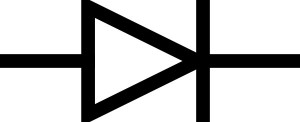If you are working on a faulty Laptop or similar with an external power supply, you may find that the PSU trips out when connected to the power socket. This can be caused by many things, but a suspect diode is usually a favourite of mine. Maybe this information might help.

With a diode, electricity flows into the “cathode” (negative side) of the diode and then out the “anode” (positive side toward the protected circuit. Diode’s are primarily used to protect delicate components in an integrated circuit such as a power supply or mainboard. A diode will only permit electricity to flow in one direction, potentially protecting components such as a power regulator IC from power spikes, over voltage or even polarity reversal. Although there are several types of diodes (Zener/rectifier/LED etc) the following information is aimed at standard glass diodes or similar. To test a diode it must be removed from circuit or at least one end lifted from the board. Connect your multimeter and check that you get a reading in ONE direction only. If you get continuity in both directions (reverse the meter probes to check each direction) then you have a bad diode. It is sometimes possible to actually see a broken diode using a magnifying glass. Removal of a diode in some cases will “fix” the faulty device. This is not recomended as the diode is there to protect the circuit and sometimes simply removing it will render the device unsafe – anti smoke & fire!
On the board a diode is usually marked with a screen printed “glyph”:
This features a vertical line that represents the cathode (negative) and a arrow that points to this line. The cathode must face the the negative current flow on the board. The new diode will have a band or dot printed on the cathode end. If you are not sure you can easily find the polarity using a multimeter. Set the meter to Ohms, hold the black probe to one end and the red to another. If you get no reading or just 1 (on a digital multimeter) then reverse the probes. When you get an actual reading, note that the black probe is in contact to the cathode (negative) side of the diode.
(Remember if you get continuity in both directions, the diode is blown)
